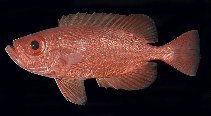| Family: |
Priacanthidae (Bigeyes or catalufas) |
| Max. size: |
36.1 cm FL (male/unsexed); max.weight: 403.0 g |
| Environment: |
reef-associated; marine; depth range 15 - 30 m |
| Distribution: |
Indo-Pacific: Gulf of Aden to Samoa, north to the Philippines and south to the Great Barrier Reef. Often confused with the wide-ranging Priacanthus hamrur. Reports from Taiwan are misidentifications of Priacanthus sagittarius (in Lee, 1980) and Heteropriacanthus cruentatus (in Shen, 1984). |
| Diagnosis: |
Dorsal spines (total): 10-10; Dorsal soft rays (total): 12-14; Anal spines: 3-3; Anal soft rays: 13-16. Variable from plain reddish-brown to a silvery, with red blotches or bands. Can change quickly with mood (Ref. 48635).
Description: Characterized by the following: soft portion of dorsal fin about equal to spinous portion or slightly taller, rounded posteriorly; rounded to truncate caudal fin; poorly developed preopercular spine and inconspicuous in adult (Ref. 90102). |
| Biology: |
Occurs in lagoon and seaward reefs, under ledges or in caves by day (Ref. 9710); often silty habitat (Ref. 48635). Solitary or in small groups (Ref 90102). Rarely trawled (Ref. 30573). |
| IUCN Red List Status: |
Least Concern (LC); Date assessed: 10 March 2015 Ref. (130435)
|
| Threat to humans: |
harmless |
Source and more info: www.fishbase.org. For personal, classroom, and other internal use only. Not for publication.

